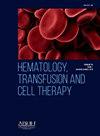Outcomes of thrombotic thrombocytopenic purpura patients submitted to therapeutic plasma exchange in a single center in Brazil
IF 1.8
Q3 HEMATOLOGY
引用次数: 0
Abstract
Introduction
Immune thrombotic thrombocytopenic purpura (iTTP) is characterized by acute systemic microvascular thrombosis and is associated with a high morbidity and mortality, especially in delayed diagnosis (later than 6–7 days from symptoms). iTTP data in Brazil is scarce, so we aimed to characterize the clinical presentation and identify predictors of death risk in patients with this disease in Brazil.
Methods
In this single-center retrospective study the patients who underwent therapeutic plasma exchange (TPE) for presumptive or confirmed iTTP were evaluated regarding the epidemiological, clinical, laboratorial characteristics and management.
Results
A total of 50 patients (90 % female), with median age (IQR) of 34.1 (27–47) years, were enrolled, of which 12 (24 %) died. The most frequent symptoms were neurological (96 %), bleeding (76 %), gastrointestinal (52 %), fever (38 %), and cardiovascular (22 %). Neurological focal deficit and cardiovascular symptoms were more frequently observed in the non-survivor group (P = 0.0019 and P = 0.007, respectively). The mean ± SD number of days from beginning of symptoms to first TPE was 12.22 ± 7.91. We identified an association regarding mortality rate with a score MITS ≥ 2 points (P = 0.04), a higher indirect bilirubin (P = 0.0006), a higher number of transfused red blood cell units (P = 0.025), and platelet transfusion (P = 0.027).
Conclusion
Delayed diagnosis appears to be associated with a higher frequency of neurological symptoms and mortality. Intensity of hemolysis and signs of organ ischemia, such as cardiovascular symptoms and focal neurological deficit, are indicators of death risk.
巴西一家中心接受治疗性血浆置换的血栓性血小板减少性紫癜患者的治疗结果
免疫性血栓性血小板减少性紫癜(iTTP)以急性全身微血管血栓形成为特征,具有高发病率和死亡率,特别是在延迟诊断时(症状出现后6-7天)。巴西的iTTP数据很少,因此我们的目的是描述巴西该疾病患者的临床表现并确定死亡风险的预测因素。方法采用单中心回顾性研究方法,对推定或确诊iTTP患者行治疗性血浆置换(TPE)的流行病学、临床、实验室特征及处理进行评价。结果共纳入50例患者(90%为女性),中位年龄(IQR)为34.1(27-47)岁,其中12例(24%)死亡。最常见的症状是神经系统(96%)、出血(76%)、胃肠道(52%)、发烧(38%)和心血管(22%)。神经局灶性缺陷和心血管症状在非幸存者组中更常见(P = 0.0019和P = 0.007)。从出现症状到首次TPE的平均±SD天数为12.22±7.91。我们发现死亡率与MITS≥2分(P = 0.04)、较高的间接胆红素(P = 0.0006)、较高的输注红细胞单位数(P = 0.025)和血小板输注(P = 0.027)有关。结论延迟诊断可能与神经系统症状和死亡率较高有关。溶血的强度和器官缺血的迹象,如心血管症状和局灶性神经功能缺损,是死亡风险的指标。
本文章由计算机程序翻译,如有差异,请以英文原文为准。
求助全文
约1分钟内获得全文
求助全文
来源期刊

Hematology, Transfusion and Cell Therapy
Multiple-
CiteScore
2.40
自引率
4.80%
发文量
1419
审稿时长
30 weeks
 求助内容:
求助内容: 应助结果提醒方式:
应助结果提醒方式:


